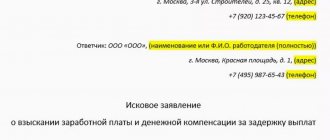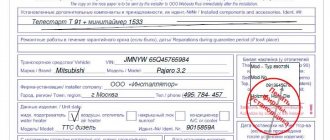Author
Sergey Ershov
Registration number in the register of lawyers of St. Petersburg – 78/5563
We made a long-awaited purchase, and a month later the item broke down. Agree, this is not a very pleasant situation. However, in this case, the manufacturer may establish a warranty on the product. I will tell you what the warranty period of a product is, from what moment it begins, how to use it and defend your rights if the seller refuses to return you.
What is meant by warranty period
The warranty period is understood as the period during which, if a defect is identified in the purchased product, you can make demands regarding the quality of the product to the manufacturer (performer), seller (authorized organization/individual entrepreneur, importer), and the latter must satisfy them - clause 6 of Art. 5 No. 2300-1 Law of the Russian Federation.
As a rule, such a period is established for durable non-food products. For example, for household appliances, vehicles, clothing, etc.
The warranty period can be set to:
- Main product.
- Its components.
- Components of the main product.
This period may be calculated:
- Time parameters - days/months/years.
- Warranty period (depending on the period of use and/or intensity of operation of the product) - for example, a 3-year warranty or 100,000 km of mileage (for vehicles)/number of operational repetitions, etc.
In practice, the first guarantee option is most often used. In this case, the duration of the warranty period can be any; the law does not limit it.
In addition to the warranty period, there are also:
- The warranty period for a product/product is the maximum possible operating time of the product.
- The shelf life of products/products that tend to lose the necessary qualities during storage is the time interval during which the manufacturer guarantees the safety of the product, the preservation of its consumer properties and the unchanged performance characteristics.
- The shelf life of goods is the time period after which the product is considered unfit for consumption.
- Service life is the time interval during which the manufacturer provides the buyer with the opportunity to use the item for its intended purpose and is responsible for any significant deficiencies found.
See also: Car warranty by law in 2021 - what it includes and what to do if consumer rights are violated
What nuances should you know about the warranty?
When returning a product during the warranty period, please be aware of the following:
- If the product was under warranty repair, the warranty period is extended for such a period - clause 3 of Art. 20 No. 2300-1 Law of the Russian Federation.
- When replacing a faulty product with a new one, the period begins again - clause 2 of Art. 21 No. 2300-1 Law of the Russian Federation.
- Equal warranty periods are established for the main product and its components, and a uniform procedure for calculating them is applied, unless otherwise provided by the contract - clause 3 of Art. 19 No. 2300-1 Law of the Russian Federation.
- When a contract establishes a warranty of shorter duration for components and components of a product than for the main product, claims can be made during the period of the main product, unless otherwise provided by the contract. If the duration is longer than for the main product, you should be guided by the longer one.
- Replacement of goods under warranty must be made by the seller within 7 days from the date of presentation of the specified requirement. If product quality control is required, within 20 days. If the seller does not have a suitable replacement, the period may be extended to 30 days - Art. 21 No. 2300-1 Law of the Russian Federation.
Who sets the warranty period?
Such a period may be established - Art. 5 No. 2300-1 Law of the Russian Federation:
- Manufacturer.
- Seller.
The retail outlet does not have the right to reduce the warranty period established by the manufacturer, but can only extend it.
If the manufacturer does not set such a period or the seller decides to increase it in addition to the manufacturer’s warranty (I’ll talk about this later), the retail outlet issues its own obligation. However, if the seller withdraws the manufacturer’s warranty card and replaces it with his own document, this is illegal.
Let me give you an example. The manufacturer has a 3-year warranty on the refrigerator. The seller gives the buyer his warranty card for a period of 1 year (instead of the manufacturer’s document) and invites him to buy an additional warranty for another 2 years. Such actions of the seller are nothing more than deceiving the consumer and providing false information about the product.
Where can the warranty period be specified?
You can find out information about the warranty at:
- Warranty card.
- Agreement.
- Service/warranty book.
- Technical documentation for the product.
The concept of product warranty period
The warranty period is the period during which the consumer, upon detection of any shortcomings and defects in the purchased product, can present to the seller (manufacturer, authorized organization or individual entrepreneur, importer) demands regarding the quality of the product (return, replacement, free elimination of the defect , price reduction, etc.), and they are obliged to satisfy the legal requirements of the consumer (clause 6 of Article 5 of the Law on the Protection of Consumer Rights).
The warranty period is established for durable non-food products. For food products, as well as non-durable and disposable goods, such as cosmetics, perfumes, sanitary and hygiene items, medicines, dietary supplements, household chemicals, the manufacturer must set an expiration date.
Warranty periods vary depending on the nature of the product. For example, for cars and other transport these periods are set from two years, for household appliances from six months, for clothes and shoes from one to several months or a year. If we are talking about a shared construction project, then a special law on shared construction obliges the developer to establish a warranty period for such an object for at least 5 years.
It is necessary to take into account the operating conditions and the owner’s compliance with the rules of use, storage or transportation of the goods, i.e. actions of the consumer themselves can lead to premature wear and damage to the product.
Article 476 of the Civil Code of the Russian Federation and paragraph 6 of Article 18 of the Law on the Protection of Consumer Rights directly stipulate that the seller is responsible for defects in the goods identified during the warranty period only if he does not prove that the defects arose precisely through the fault of the consumer himself after the goods were transferred to him , i.e. for reasons beyond the control of the seller or manufacturer.
We are talking about those cases when a thing fails completely or partially with proper and correct use.
It happens that you buy new boots or a coat, and a month later you discover a tear in the fabric, a peeling sole, characteristic stains in the color of the product, a broken zipper, or a hole in a leaky place on the fabric, or a recently purchased household appliance or expensive gadget suddenly breaks down. In such cases, one can raise the question of inadequate quality of the product; we can also talk about a manufacturing defect of the product.
Consumer rights lawyer in St. Petersburg. Tel.+7 (812) 989-47-47 Telephone consultation
What types of guarantee are there?
There are two types of guarantee - Art. 470 Civil Code of the Russian Federation:
- Legal (mandatory) - guarantees, at the time of transfer of the product to the consumer, that the product has no defects that affect its value reduction/suitability for the purposes for which it is usually used within a reasonable period.
- Contractual - provision by the manufacturer/seller of a guarantee of the quality of the goods during a certain time interval established by the contract.
What is an additional product warranty?
In addition to the main guarantee when purchasing a product, the seller may offer you an additional guarantee. Next I’ll tell you what it is.
An additional guarantee is the same guarantee of the manufacturer/seller, according to which they assume an additional obligation in relation to defects in the product discovered after the end of the warranty period established by the manufacturer (clause 6 and clause 7 of Article 5 No. 2300-1 of the Law of the Russian Federation) .
This guarantee is also called an additional service certificate. This service is paid. It provides free repair of the product in service centers if manufacturing defects/other breakdowns are detected. In this case, the choice of service lies with the seller.
What to look for when purchasing an additional warranty
Please read the terms and conditions of the certificate carefully:
- The start and end dates of its validity, since it may coincide with the warranty established by the manufacturer/seller.
- The volume and nature of the warranty obligations (usually indicated in the warranty card) and the obligations assumed by the contractor under the additional warranty. Compensatory obligations may duplicate gratuitous ones (which must be provided to the consumer free of charge).
Please note that large companies that provide such guarantees only accept equipment for repair if the cause of the breakdown is a manufacturing defect.
If you are convinced to purchase an additional warranty in case of breakdowns resulting from, for example, a voltage drop in the network/your careless actions, etc., most likely the repair will be carried out at an unauthorized service center.
Important! If you do not use it during the validity period of the additional warranty, you will not be able to get the money paid for it back.
The product warranty period has expired
The expiration of the warranty period of a product does not always exclude the possibility of its return or exchange if defects are found in it outside the warranty period.
According to paragraph 5 of Article 19 of the Law on the Protection of Consumer Rights, the consumer has the right to present a claim to the seller or manufacturer regarding the quality of the product if:
- The warranty period for the product is less than 2 (two) years
- The defect was discovered after the expiration of the warranty period, but within 2 (two) years
- The consumer will prove that the identified defect arose before the seller transferred the goods to him, or for reasons that arose before the sale of the goods to him (in the event of a dispute about the nature of the defect)
Let's give an example: the warranty on the phone is 1 year; during the first year, warranty repairs were carried out, but during the second year of operation, the defect appeared in the phone again. In this case, despite the expiration of the warranty period, the consumer will have the right to make a claim to the seller for the return, replacement or repair of the phone, only on the condition that the consumer provides evidence that the identified defect is of a hidden manufacturing nature, i.e. arose before the transfer to him, or for reasons that arose before the sale of the goods. Such evidence will be an independent expert opinion confirming this fact. The examination is carried out at the expense of the consumer, and if it confirms the manufacturing nature of the defect, you can present to the seller (manufacturer) one of the requirements provided for in Article 18 of the Law on the Protection of Consumer Rights, attaching an expert opinion to the claim, and you can demand reimbursement of the costs of the examination.
In addition, the manufacturer or seller may voluntarily assume additional obligations with respect to product defects discovered outside the manufacturer's warranty period.
The conditions, terms and procedure for fulfilling the additional obligation are established by the manufacturer himself. When such an obligation is accepted by the seller, all conditions are specified in the agreement (contract) between the seller and the consumer.
If additional obligations of the manufacturer or seller exist, but a dispute has arisen between the parties regarding the nature of the defect, the following nuances of distribution of the burden of proof of the nature of the identified defect must be taken into account:
- If defects in the goods are discovered during the period of the additional obligation of the manufacturer or seller, the burden of proving the nature of the defect lies with the manufacturer or seller.
- If after the expiration of the additional warranty, but within two years after the transfer of the goods to the consumer, then the burden of proving the occurrence of defects in the goods before its transfer to the consumer or for reasons that arose before this moment falls on the consumer himself.
What does the product warranty provide?
The warranty determines the limits of the seller’s liability when selling a low-quality product.
The presence of a warranty period allows the consumer to purchase not only truly high-quality products, but also to count on the elimination of defects that appeared during operation, which were not specified during the sale at the expense of the manufacturer/seller.
So, if the product turns out to be of inadequate quality (with the exception of a technically complex product), you can demand - Art. 18 No. 2300-1 Law of the Russian Federation:
- Price reductions.
- Replacement of a product with a similar/different brand (with recalculation of its cost).
- Repair/reimbursement of expenses incurred to eliminate the defect.
- Refund.
As for complex technical products, if defects are found in them, you also have the right to count on a refund of the money paid or a replacement, but claims must be submitted within 15 days. If this period has expired, you can first request only repairs.
However, a refund beyond 15 days is still possible if:
- The defect turns out to be irreparable/the seller refused to repair you.
- The repair period under warranty was violated (45 days).
- The product was repaired for a total of more than 30 days during each warranty year.
Please note that the manufacturer has the right to establish conditions for providing a warranty for the product. Thus, the consumer must comply with the operating conditions and use the product in accordance with its purpose and instructions. For example, the owner of a vehicle must undergo regular maintenance.
See also: How to return your phone under warranty in 2021 - 5 simple steps
What is guaranteed to the consumer when purchasing a product?
During the warranty period after the seller transfers the product to the buyer, it must - Art. 469 Civil Code of the Russian Federation:
- Comply with the description set out in the sales contract/sample.
- Suitable for the purposes for which it is normally used.
- Meet increased quality requirements, if provided for by agreement of the parties.
The product quality guarantee also applies to all its components, unless otherwise provided by the contract.
See also:
How to return a technically complex product in 2021 - step-by-step instructions
How to return a product under warranty in 2021 - 7 simple steps
Warranty for components and components of the product
The manufacturer may establish a warranty period separately for components or components of the main product (clause 3 of Article 19 of the Law on the Protection of Consumer Rights). The warranty period for them is calculated in accordance with the general procedure.
Therefore, a return or exchange of component parts of a product is possible regardless of the quality of the main product .
There are the following features of the warranty period for components and components of the main product:
- If the warranty period for a component product or component is set to be shorter than for the main product, the consumer has the right to make a claim regarding the quality of such product or part of the product during the warranty period for the main product.
- If the warranty for a component product or component of a product is greater than the warranty for the main product, the consumer may make a claim regarding the quality of the product provided that defects in the component product are discovered during the warranty period for this product, regardless of the expiration of the warranty period for the main product.
When does the warranty period begin?
The law allows you to determine the beginning and end of the guarantee. The warranty period for the product begins to run from the moment - Art. 471 Civil Code of the Russian Federation, art. 19 No. 2300-1 Law of the Russian Federation:
- Transfer of the product to the consumer - unless another procedure is established by the contract.
- Manufacture of the item - if the date of purchase is unknown.
- Elimination by the seller of certain circumstances (special installation/connection/assembly is required or a defect is detected) - if the consumer cannot, therefore, use it for its intended purpose and notifies the seller about this. If it is impossible to establish the date - from the moment of conclusion of the purchase and sale agreement.
- Delivery of goods to the buyer - when selling products by samples/by mail/remotely. If the date is unknown, calculation begins from the moment the purchase and sale agreement is signed.
- The onset of the corresponding season, the duration of which is determined taking into account the climatic conditions of the buyer’s location - when purchasing seasonal goods (clothes/shoes and other things used by buyers, depending on the time of year).
Important! The warranty periods for components are calculated in the same manner as for the main item.
Who sets the warranty period for a product?
According to Article 5 of the Law on the Protection of Consumer Rights, the warranty period for a product can be established:
- Manufacturer
- By the seller (if the warranty period is not established by the manufacturer)
As we see, first of all, the manufacturer has the right to establish a warranty on a product, while the seller acquires such a right only in the absence of a factory warranty.
Thus, the law excludes the possibility of establishing two guarantees for the same product.
For information about in what cases requirements regarding poor quality of goods are presented to the manufacturer, seller or importer, and in what cases the consumer is provided with an alternative, read the article return of low-quality goods.
What to do if a warranty claim occurs
In the event of a warranty claim, adhere to the following algorithm:
- Check to see if you are legally entitled to return the product and if you have missed the deadline for making a claim.
- Decide on the requirements and prepare a claim, attaching the necessary documents (I will talk about them later). I described how to draw up and send it in more detail in the article How to make a claim for a refund for a product of inadequate quality in 2021.
- Send the application to the seller by mail (a valuable letter with a list of attachments) to his legal address or hand over the document in person. Be sure to mark your copy upon receipt.
- Hand over the defective goods to the seller according to the acceptance certificate. If the product is small, this can be done simultaneously with submitting the claim. For bulky/heavy items (weighing more than 5 kg) delivery will be required. In this case, such transportation must be provided by the seller at his own expense and on his own.
- Depending on the requirements set out in your claim, the seller must: return the money within 10 days of receipt of the claim / replace the product with a new one within 7 days (if additional inspection is carried out - 20 days) / make repairs within no more than 45 days .
- If the above deadlines are violated, prepare a complaint to Rospotrebnadzor/statement of claim to court.
- Before filing a claim in court, send to the Defendant (seller) one copy of the application with copies of the attached documents by a valuable letter with a list of the attachments.
- Submit a statement of claim to the court office in person/through a representative or send it by mail/via the electronic service of State Automated Information System “Justice”.
- Take part in the trial. If a judicial decision is not in your favor, appeal.
- After a positive court decision comes into force, receive a writ of execution and send it to the bailiffs for execution.
See also:
Where to complain to a consumer if rights are violated in 2021
How to write a statement on consumer protection in 2021 - step-by-step instructions + sample
What documents are needed to take advantage of the guarantee?
To “painlessly” return a product under warranty to a store, you must confirm that the product was purchased at this particular retail outlet.
In this regard, you must have the following documents with you:
- Payment document confirming the fact of purchase - cash receipt/sales receipt/bank account statement.
- Warranty card.
- Purchase and sale agreement (if available).
- Other.
Please note that the absence of such documents cannot be a reason for refusing to satisfy your requirements - clause 5 of Art. 18 No. 2300-1 Law of the Russian Federation.
If you lose payment documents, you can refer to:
- Witness's testimonies.
- Video recordings from surveillance cameras.
- Warranty card.
- Bank statement for personal account (if paying by bank transfer).
- SMS/PUSH messages about debiting money from a card, etc.
What additional information do you need to know about the product warranty period?
- The warranty period of the product is extended for the period of warranty repair (clause 3 of Article 20 of the Law on the Protection of Consumer Rights)
- When replacing a product, the warranty period begins again, i.e. from the moment of replacement (clause 2 of Article 21 of the Law on Protection of Consumer Rights)
- When replacing a component or component of a product, the warranty for the new product or component begins again, i.e. from the moment the goods are returned from repair (clause 4 of Article 20 of the Law on the Protection of Consumer Rights)
- The warranty period is calculated in units of time: years, months, days; and other units of measurement, depending on the functions and purpose of the product: kilometers, meters, etc. (clause 3 of Article 5 of the Law on the Protection of Consumer Rights)
- Information about the warranty period for the product is indicated in the warranty card, in the receipt or in the sales contract. The manufacturer's warranty is usually stated in the technical documentation for the product.
Consumer rights lawyer. Tel.+7 Telephone consultation
How long does it take for the seller to carry out warranty repairs?
The duration of repairs under warranty is determined as follows - clause 1 of Art. 20 No. 2300-1 Law of the Russian Federation:
- Immediately (as soon as possible) - if the parties have not agreed in writing on the deadline for eliminating defects.
- Within the period stipulated by the parties, but not more than 45 days - if the period is approved by you in writing.
This rule applies to the entire category of goods.
Important! If the repair period was violated/you repeatedly contacted the service center to repair the product (in total more than 30 days in each warranty year), feel free to submit a claim again and demand a refund.
What can you demand from the seller during the repair period under warranty?
During the period of warranty repair of a durable product, you can demand that the seller provide you with a similar product for free use within 3 days. In this case, the retail outlet is obliged to deliver it to you at its own expense.
However, there are exceptions to this rule. RF PP No. 2463 approved the List of durable goods to which the above requirement does not apply:
- Auto-moto vehicles/trailers and numbered units for them. An exception is products intended for the disabled/recreational boats and watercraft.
- Furniture.
- Electrical appliances.
- Electric/gas/hybrid household appliances used for heating/cooking.
- Civilian weapons. Jewelry and other products made of precious metals/precious stones.
Transfer of goods under warranty for repair
The actions of a buyer who puts forward demands for repair of a product under warranty, when the seller (importer, manufacturer), in turn, recognizes the case as under warranty and undertakes to carry out the repair free of charge, are divided into several stages:
- Contacting the seller with a written statement, which demands that the identified deficiencies be eliminated free of charge. The application is drawn up in two copies and handed over to the obligated person against signature.
- Transfer of low-quality goods to the seller. This action is formalized by an act of acceptance of the goods from the buyer to the seller. The act must necessarily indicate such information as: the date of transfer of the goods, who handed over and who accepted the goods, a detailed description of the defective goods with a note about the serial number, traces of use and the presence of external damage, the presence (absence) of factory seals, a description of the signs of the defect, confirmation the seller about the warranty case and acceptance of the product for repair.
Important! If the goods are large (weighing more than 5 kg), the rights of the consumer of the goods under the guarantee include requirements for delivery of the goods from the location and back at the expense of the seller, or compensation for expenses for self-delivery.
- Checking the quality of the goods. This action can be carried out immediately on the spot or, if it is impossible to quickly determine the cause of the malfunction, over a period of time. In the latter case, the goods are carefully packaged to prevent unauthorized persons from accessing them without the participation of the buyer, the packaging is signed by the seller and the buyer, and a corresponding note is made in the transfer certificate.
If the seller checks the product to identify a manufacturing defect without the presence of the buyer, the results of this examination can be safely questioned, asserting your rights as a consumer.
- Replacement of the product with an alternative one during repairs. This option is a consumer right based on the Product Warranty Act. The requirement is stated in writing directly in the application. The seller is obliged to provide the buyer with a free temporary replacement of the goods within 3 days. Temporary replacement of goods is not provided for: vehicles, household electrical items for personal use and cooking, interior items, civilian weapons.
- Return of goods after warranty repair includes:
- Notifying the buyer about the possibility of receiving the goods back.
- Careful inspection by the consumer to ensure that there are no newly discovered defects.
- A clear demonstration of the serviceability of the product.
- Providing a certificate-report on the repair performed, indicating in it: the date of acceptance for repair, the period of repair, identified faults, a description of the spare parts and components used, confirmation of the elimination of the defect, the date of return of the goods to the buyer.
The period for returning goods under warranty, in accordance with the law, is 45 days. The fine for each day of delay, which is imposed on the seller, is 1% of the cost of the goods. Transferring a defective product to the seller for repair involves extending the warranty period for the product.
- Additional actions during repairs. In practice, there are often cases when the seller, while repairing a product within the warranty period, takes actions that go beyond the scope of the warranty (for example, installs a new version of the operating system on a computer), explaining this as a necessary solution to improve the quality of the equipment and, accordingly, demanding for this payment from the buyer.
Important! If there was a case of performing any additional work without notifying the buyer and obtaining his permission, the latter has the right not to pay the seller’s expenses incurred. In this case, there will be no forced collection of payment.
Actions of the buyer in case of refusal of the seller to repair the product under warranty:
- Contacting the seller with a request to eliminate the identified defects free of charge.
- Organizing and conducting an examination, during which the seller identifies a non-warranty case and refuses to perform free repairs. In this situation, the buyer will need to check the goods with the involvement of independent specialists at his own expense. If a manufacturing defect is confirmed, all costs will be charged to the seller in court.
- Applying to the court with a claim for the protection of consumer rights. First, the buyer must send a pre-trial claim to the seller to resolve the conflict, referring to the conclusion of an independent merchandising examination.
- Obtaining a writ of execution after the court decision has entered into legal force.
We recommend! It is best to entrust the preparation and conduct of a case to protect consumer rights in court to a professional lawyer.
When can a consumer be denied warranty service?
In some cases, the consumer may be denied service under the warranty. Namely, if the seller proves that the defect appeared after the product was handed over to you, as a result of clause 6 of Art. 18 No. 2300-1 Law of the Russian Federation:
- Its improper operation/storage/transportation.
- Force majeure.
- Interventions by others.
If such circumstances are confirmed, the seller (manufacturer), authorized organization/individual entrepreneur, importer, is not responsible for any defects in the product and will refuse to service you. In this case, you will have to pay for repair work at your own expense.
How to defend consumer rights when warranty repairs are refused
Decide on a method to protect the violated right.
If the retail outlet/manufacturer/service center unreasonably refused to service your product under warranty, prepare a complaint to Rospotrebnadzor.
Such an appeal must be considered by the supervisory authority within 30 days from the date of its receipt. Based on the results of its consideration, if the violation is confirmed, an order to eliminate it will be sent to the seller.
In addition, an independent examination is also recommended. If the result confirms a manufacturing defect, the store will reimburse you for the money you paid for the product.
If the out-of-court procedure does not produce results and the money is still not returned to you, file a claim in court. I described in more detail how to draw up a claim, in which court and in what way to file it in the article Sample statement of claim to the court for the return of funds in 2021.
Will the warranty apply if the product was purchased abroad?
When purchasing a product from a foreign manufacturer abroad, Russian laws do not apply. Here a lot depends on the “policy” of the manufacturer. If the product is certified in Russia, you can apply for warranty to authorized service centers with which the manufacturer has an agreement. If not, you will be rejected.
However, you have the right to contact the manufacturer in accordance with the regulations of the state where the item was purchased. Also, if there is a representative office of such a foreign company in the Russian Federation, you can try contacting them. Perhaps they will help you resolve this issue.
How to use the guarantee?
If a warranty case does occur and the purchased product turns out to be defective, first of all the buyer should decide what type of warranty he would like to receive. After making a decision you must:
- Write a letter to the store administration in 2 copies. The complaint must describe in detail what exactly is not satisfactory about the product and also indicate the desired type of compensation (exchange, refund or repair of the product).
- A copy of the sales receipt and the completed warranty card must be added to the claim.
- The written letter must be taken to the administrator of the store where the purchase was made or to the nearest service center. The addresses of service centers are indicated in the warranty card.
- One copy of the letter is given to the administrator of the store or service center. The second copy with the seller’s signature and seal, as well as the indicated date of filing the claim, remains with the buyer.
After this, unless it is proven that the user is to blame for the breakdown, warranty obligations must be fulfilled within the time limits established by consumer law:
- refund - no later than 10 days. After this period, from the 11th day a penalty of 1% per day is charged;
- exchange - no later than 7 days. With additional examinations, the period may be increased to 20 days;
- repair - 45 days.
What is the liability for violating the terms of warranty repairs?
If the seller violates the deadlines for such repairs, he becomes liable in the form of an obligation to:
- Refund of money paid for the product - if the repair lasted more than 45 days.
- Compensation for losses.
- Payment of a penalty (penalty) in the amount of 3% of the cost of repair work for each day of delay.
Important! Paying a penalty does not relieve the retailer from the obligation to satisfy your stated requirements.
What to do if a defect is discovered after the warranty has expired
If the warranty period has expired, the seller has the right to refuse warranty service to you. However, if a significant defect is discovered in the product outside of this period, you can submit a demand for its elimination to the manufacturer (authorized organization/individual entrepreneur, importer) in - clause 6 of Art. 19 No. 2300-1 Law of the Russian Federation:
- Product service life period.
- For 10 years from the date of delivery of the product to you - unless such a period is established.
The only thing is that you will have to prove that the defect arose before the time of purchase or due to circumstances that arose before that moment. This will require an independent examination.
Product expiration date. Product service life and warranty period
When purchasing a food or non-food product, most buyers always check the expiration date or service life of the product.
What you need to know about the expiration date:
- The expiration date is mandatory set by the manufacturer (performer) for food, cosmetics, perfumes, medicines, household chemicals, hygiene items, dietary supplements and other similar products.
- If there is no expiration date, or after the expiration of this period, such goods are prohibited for sale, since they can pose a serious danger to the life and health of the consumer.
- The consumer has the right to file a claim with the seller (manufacturer) during the shelf life of the product
What are the features of the product service life:
- The service life is set by the manufacturer for durable goods, at will. During the service life, the manufacturer undertakes to ensure that the product is suitable for its intended use, i.e. the product must serve while maintaining the qualities declared by the manufacturer, and in the event of significant defects in the product, the manufacturer must bear responsibility for them as provided for by law.
- For durable goods and their components, which after a certain period may become dangerous to the life and health of the consumer, as well as to the environment, or cause damage to the consumer’s property, the manufacturer is obliged to establish a service life so that the requirements for product safety can be met, i.e. e. the consumer must be informed for what period of time such a product is safe to use. The list of such goods was approved by Decree of the Government of the Russian Federation dated June 16, 1997 No. 720 (as amended on May 10, 2001).
Consumer rights when a significant defect in a product is discovered during the service life of the product:
- If during the service life of the product, even after two years after the delivery of the product to the consumer (or within 10 years if the service life is not established), a significant defect is discovered in it, the consumer has the right to present to the manufacturer or authorized organization or importer a demand for free repair .
- The only condition for presenting the above requirement is that the consumer must prove that a significant defect arose before the goods were transferred to him or for reasons that arose before that, i.e. production or hidden nature of the deficiency.
- The manufacturer is obliged to satisfy the requirement to eliminate a significant defect in the product free of charge within 20 (twenty) days from the date of filing the claim.
- If the consumer's request for gratuitous elimination of the defect within 20 days is not satisfied, the consumer has the right to demand replacement or return of the product, or make other demands provided for in Article 18 of the Law on the Protection of Consumer Rights.
- If an examination of a product establishes that a defect identified during its service life (or within 10 years in the absence of a service life of the product) is irreparable, the consumer has the right to immediately demand that the manufacturer or importer exchange or return such goods (clause 6 of Article 19 of the Law on protection of consumer rights), bypassing the stage of free elimination of product defects.
FAQ
Q: Does the warranty apply to items purchased on sale?
A: Products purchased on sale are also covered by the warranty. The only exceptions are those goods for which the consumer was notified of the reason for the markdown in writing (for example, an entry in the receipt/instructions, etc.).
Q: Where is warranty repair of equipment performed?
A: Warranty equipment is repaired at authorized service centers. Such services have a special license and undergo periodic certification. They carry out their activities on the basis of a concluded agreement with the manufacturer of the goods. When repairing, they must: 1) use only original spare parts; 2) carry out repair work according to technology.
Q: What happens if a product under warranty cannot be repaired?
A: If the product cannot be repaired, the seller must refund you the full price of the product.
Q: What should I do if the retail outlet where the product was purchased has disappeared and there is no information about it?
A: If the seller has disappeared (the store has closed/the legal entity has changed), this does not mean that you should lose your warranty. When an organization changes its legal form, find out whether it is a successor to the previous one. If not and the seller cannot be found, file a claim with the manufacturer/importer. If you receive a refusal, appeal to the court.
What products are covered by the warranty?
When a purchased product or service does not meet quality standards, has flaws or defects. The period for providing free service cannot be less than 2 years for technically complex products or 6 months for others. That is, even if the warranty card indicates a shorter period, and a breakdown or defect of the product is discovered after its expiration, the buyer can make a claim to the store and demand free repairs.
The service period begins on the date of purchase specified in the sales contract. For clothing and shoes, this countdown begins from the first day of the season for which the item is intended. For example, for a fur coat it will start on December 1st.
IMPORTANT
The obligation is valid only if the breakdown or the reasons leading to it occurred before the transfer of the goods to the buyer.
Remember
- Establishing a warranty period for products is the right of the manufacturer/seller, and not an obligation.
- The guarantee can be legal or contractual. Also, the seller/manufacturer may provide an additional guarantee in respect of a defect in the product discovered after the end of the warranty period established by the manufacturer.
- Warranty information may be indicated in the warranty card/service book/contract/technical documentation for the product.
Have you ever had to contact the seller for warranty? What did you choose - repair, replacement of goods or refund?
Product without warranty period
Let us remind you that the consumer can return the goods during the warranty period. However, establishing a warranty period for a product is not the responsibility of the manufacturer or seller , but their right. Don’t be surprised if, after purchasing something, you discover that there is no warranty period. This does not mean that if a defect is detected, such a product cannot be returned.
The requirements established by Article 18 of the Law on the Protection of Consumer Rights regarding the quality of a product for which a warranty period is not established can be presented if :
- Defects in the goods were discovered within a reasonable time, but within two years from the date of delivery of the goods
- The consumer will prove the occurrence of the defect before the goods were sold to him, or for reasons that arose before that moment (in the event of a dispute about the nature of the defect)
It is best to contact the seller (manufacturer) immediately upon discovering a defect in the product, without waiting for a two-year period, and completely exclude further use of the item, since in the event of a trial, it is possible to conduct an expert examination of the product in order to establish the causes of the defect. Therefore, it is in the consumer’s interest to report a defect immediately after its discovery, this will allow the nature of the defect to be most accurately determined. The court can determine the reasonableness of the period for identifying a defect if the dispute is not resolved pre-trial, based on the features and characteristics of the goods, as well as the terms usually established for similar goods.










